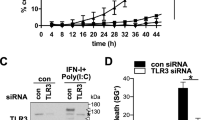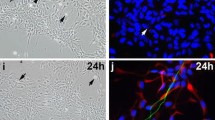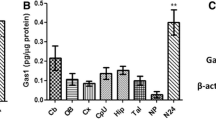Abstract
Growth Arrest Specific 1 (GAS1) is a protein expressed when cells are arrested and during development. When ectopically expressed, GAS1 induces cell arrest and apoptosis of different cell lines, and we have previously demonstrated that the apoptotic process set off by GAS1 is caused by its capacity inhibiting the GDNF-mediated intracellular survival signaling. In the present work, we have dissected the molecular pathway leading to cell death. We employed the SH-SY5Y human neuroblastoma cell line that expresses GAS1 when deprived of serum. We observed, as we have previously described, that the presence of GAS1 reduces RET phosphorylation and inhibits the activation of AKT. We have now determined that the presence of GAS1 also triggers the dephosphorylation of BAD, which, in turn, provokes the release of Cytochrome-c from the mitochondria to the cytosol activating caspase-9, prompting the activity of caspase-3 and resulting in apoptosis of the cells. The apoptotic process is intrinsic, because there is no activation of caspase-8, thus this is consistent with apoptosis induced by the lack of trophic support. Interestingly, in cells where GAS1 has been silenced there is a significant delay in the onset of apoptosis.






Similar content being viewed by others
References
Schneider C, King RM, Philipson L (1988) Genes specifically expressed at growth arrest of mammalian cells. Cell 54:787–793
Hatinen T, Holm L, Airaksinen MS (2007) Loss of neurturin in frog–comparative genomics study of GDNF family ligand-receptor pairs. Mol Cell Neurosci 34:155–167
Stebel M, Vatta P, Ruaro ME, Del Sal G, Parton RG, Schneider C (2000) The growth suppressing gas1 product is a GPI-linked protein. FEBS Lett 481:152–158
Schueler-Furman O, Glick E, Segovia J, Linial M (2006) Is GAS1 a co-receptor for the GDNF family of ligands? Trends Pharmacol Sci 27:72–77
Evdokiou A, Cowled PA (1998) Growth-regulatory activity of the growth arrest-specific gene, GAS1, in NIH3T3 fibroblasts. Exp Cell Res 240:359–367
Evdokiou A, Cowled PA (1998) Tumor-suppressive activity of the growth arrest-specific gene GAS1 in human tumor cell lines. Int J Cancer 75:568–577
Mellstrom B, Cena V, Lamas M, Perales C, Gonzalez C, Naranjo JR (2002) Gas1 is induced during and participates in excitotoxic neuronal death. Mol Cell Neurosci 19:417–429
Zamorano A, Lamas M, Vergara P, Naranjo JR, Segovia J (2003) Transcriptionally mediated gene targeting of gas1 to glioma cells elicits growth arrest and apoptosis. J Neurosci Res 71:256–263
Zamorano A, Mellstrom B, Vergara P, Naranjo JR, Segovia J (2004) Glial-specific retrovirally mediated gas1 gene expression induces glioma cell apoptosis and inhibits tumor growth in vivo. Neurobiol Dis 15:483–491
Benitez JA, Arregui L, Vergara P, Segovia J (2007) Targeted-simultaneous expression of Gas1 and p53 using a bicistronic adenoviral vector in gliomas. Cancer Gene Ther 14:836–846
Dominguez-Monzon G, Benitez JA, Vergara P, Lorenzana R, Segovia J (2009) Gas1 inhibits cell proliferation and induces apoptosis of human primary gliomas in the absence of Shh. Int J Dev Neurosci 27:305–313
Lopez-Ornelas A, Mejia-Castillo T, Vergara P, Segovia J (2011) Lentiviral transfer of an inducible transgene expressing a soluble form of Gas1 causes glioma cell arrest, apoptosis and inhibits tumor growth. Cancer Gene Ther 18:87–99
Lopez-Ramirez MA, Dominguez-Monzon G, Vergara P, Segovia J (2008) Gas1 reduces Ret tyrosine 1062 phosphorylation and alters GDNF-mediated intracellular signaling. Int J Dev Neurosci 26:497–503
Dominguez-Monzon G, Gonzalez-Ramirez R, Segovia J (2011) Molecular mechanisms of action of Gas1 and its possible therapeutic applications. Curr Signal Transduct Ther 6:106–112
Lee CS, Buttitta L, Fan CM (2001) Evidence that the WNT-inducible growth arrest-specific gene 1 encodes an antagonist of sonic hedgehog signaling in the somite. Proc Natl Acad Sci USA 98:11347–11352
Allen BL, Tenzen T, McMahon AP (2007) The Hedgehog-binding proteins Gas1 and Cdo cooperate to positively regulate Shh signaling during mouse development. Genes Dev 21:1244–1257
Martinelli DC, Fan CM (2007) Gas1 extends the range of Hedgehog action by facilitating its signaling. Genes Dev 21:1231–1243
Allen BL, Song JY, Izzi L, Althaus IW, Kang JS, Charron F, Krauss RS, McMahon AP (2011) Overlapping roles and collective requirement for the coreceptors GAS1, CDO, and BOC in SHH pathway function. Dev Cell 20:775–787
Lee KK, Leung AK, Tang MK, Cai DQ, Schneider C, Brancolini C, Chow PH (2001) Functions of the growth arrest specific 1 gene in the development of the mouse embryo. Dev Biol 234:188–203
Seppala M, Depew MJ, Martinelli DC, Fan CM, Sharpe PT, Cobourne MT (2007) Gas1 is a modifier for holoprosencephaly and genetically interacts with sonic hedgehog. J Clin Invest 117:1575–1584
Martinelli DC, Fan CM (2009) A sonic hedgehog missense mutation associated with holoprosencephaly causes defective binding to GAS1. J Biol Chem 284:19169–19172
Ribeiro LA, Quiezi RG, Nascimento A, Bertolacini CP, Richieri-Costa A (2010) Holoprosencephaly and holoprosencephaly-like phenotype and GAS1 DNA sequence changes: report of four Brazilian patients. Am J Med Genet A 152A:1688–1694
Pineda-Alvarez DE, Roessler E, Hu P, Srivastava K, Solomon BD, Siple CE, Fan CM, Muenke M (2011) Missense substitutions in the GAS1 protein present in holoprosencephaly patients reduce the affinity for its ligand, SHH. Hum Genet. doi:10.1007/s00439-011-1078-6
Stecca B, Mas C, Clement V, Zbinden M, Correa R, Piguet V, Beermann F, Ruiz IAA (2007) Melanomas require HEDGEHOG-GLI signaling regulated by interactions between GLI1 and the RAS-MEK/AKT pathways. Proc Natl Acad Sci USA 104:5895–5900
Garcia-Tovar CG, Perez A, Luna J, Mena R, Osorio B, Aleman V, Mondragon R, Mornet D, Rendon A, Hernandez JM (2001) Biochemical and histochemical analysis of 71 kDa dystrophin isoform (Dp71f) in rat brain. Acta Histochem 103:209–224
Gobeil S, Zhu X, Doillon CJ, Green MR (2008) A genome-wide shRNA screen identifies GAS1 as a novel melanoma metastasis suppressor gene. Genes Dev 22:2932–2940
Huang Y, Prasad M, Lemon WJ, Hampel H, Wright FA, Kornacker K, LiVolsi V, Frankel W, Kloos RT, Eng C, Pellegata NS, de la Chapelle A (2001) Gene expression in papillary thyroid carcinoma reveals highly consistent profiles. Proc Natl Acad Sci USA 98:15044–15049
Bettuzzi S, Davalli P, Astancolle S, Carani C, Madeo B, Tampieri A, Corti A (2000) Tumor progression is accompanied by significant changes in the levels of expression of polyamine metabolism regulatory genes and clusterin (sulfated glycoprotein 2) in human prostate cancer specimens. Cancer Res 60:28–34
Rizzi F, Belloni L, Crafa P, Lazzaretti M, Remondini D, Ferretti S, Cortellini P, Corti A, Bettuzzi S (2008) A novel gene signature for molecular diagnosis of human prostate cancer by RT-qPCR. PLoS One 3:e3617
Zhao L, Pan Y, Gang Y, Wang H, Jin H, Tie J, Xia L, Zhang Y, He L, Yao L, Qiao T, Li T, Liu Z, Fan D (2009) Identification of GAS1 as an epirubicin resistance-related gene in human gastric cancer cells with a partially randomized small interfering RNA library. J Biol Chem 284:26273–26285
Jiang Z, Xu Y, Cai S (2011) Down-regulated GAS1 expression correlates with recurrence in stage II and III colorectal cancer. Hum Pathol 42:361–368
Bordeaux MC, Forcet C, Granger L, Corset V, Bidaud C, Billaud M, Bredesen DE, Edery P, Mehlen P (2000) The RET proto-oncogene induces apoptosis: a novel mechanism for Hirschsprung disease. EMBO J 19:4056–4063
Hamann J, Wernicke C, Lehmann J, Reichmann H, Rommelspacher H, Gille G (2008) 9-Methyl-beta-carboline up-regulates the appearance of differentiated dopaminergic neurones in primary mesencephalic culture. Neurochem Int 52:688–700
Mao L, Xia YP, Zhou YN, Dai RL, Yang X, Duan SJ, Qiao X, Mei YW, Hu B, Cui H (2009) A critical role of sonic hedgehog signaling in maintaining the tumorigenicity of neuroblastoma cells. Cancer Sci 100:1848–1855
Shahi MH, Schiapparelli P, Afzal M, Sinha S, Rey JA, Castresana JS (2011) Expression and epigenetic modulation of sonic hedgehog-GLI1 pathway genes in neuroblastoma cell lines and tumors. Tumour Biol 32:113–127
Schiapparelli P, Shahi MH, Enguita-German M, Johnsen JI, Kogner P, Lazcoz P, Castresana JS (2011) Inhibition of the sonic hedgehog pathway by cyplopamine reduces the CD133+/CD15+ cell compartment and the in vitro tumorigenic capability of neuroblastoma cells. Cancer Lett 310:222–231
Wiesenhofer B, Weis C, Humpel C (2000) Glial cell line-derived neurotrophic factor (GDNF) is a proliferation factor for rat C6 glioma cells: evidence from antisense experiments. Antisense Nucleic Acid Drug Dev 10:311–321
Acknowledgments
We want to thank Victor H. Rosales for his assistance with the flow cytometry assays, and Dr. J.M. Hernández (Cinvestav) for the kind gift of the antibody against β-ACTIN, and Dr. B. Vogelstein (Johns Hopkins University) for providing us with the pAdTrack-CMV plasmid. This work was partially supported by Conacyt (Mexico) Grant 127357 (J.S).
Author information
Authors and Affiliations
Corresponding author
Electronic supplementary material
Below is the link to the electronic supplementary material.
Rights and permissions
About this article
Cite this article
Zarco, N., González-Ramírez, R., González, R.O. et al. GAS1 induces cell death through an intrinsic apoptotic pathway. Apoptosis 17, 627–635 (2012). https://doi.org/10.1007/s10495-011-0696-8
Published:
Issue Date:
DOI: https://doi.org/10.1007/s10495-011-0696-8




